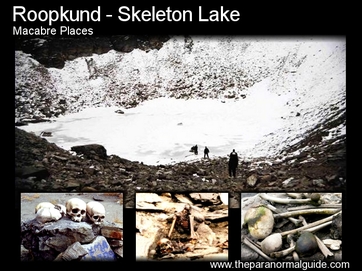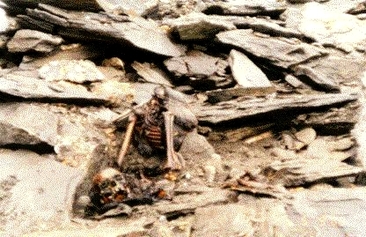
It is these remains that give Roopkund its other name - Skeleton Lake.
Frozen Lake of Bones
 The frozen 'Skeleton Lake'.
The frozen 'Skeleton Lake'. Roopkund is not known just for its beauty but more for a find that gave it it's second name – Skeleton Lake.
In the late 1800's there were reports of vast numbers of skeletons, buried/frozen in the glacial lakes ice. This was almost taken as legend as Roopkund is located almost in the middle of nowhere and the dozens of skeletons reported made no sense, it was not near any trade routes.
However in 1942 a ranger from the Nanda Devi game reserve came across the bones. There was not a few dozen skeletons but hundreds.
The early reports from the 1800's were not so common knowledge and immediate assumption was that the skeletons may have been a force of Japanese soldiers trying to sneak through this part of India on some sort of wartime mission, but dying from the elements. This assumption was soon quashed as the remains turned out to be much older than a few years.
Not knowing exactly who they were, many theories came about as to how they all died together. Landslide, blizzard, plague/disease and even ritual suicide were all put forward.
Mystery of their Identities
 Skulls found and left on rocks.
Skulls found and left on rocks. They were wrong.
In 2004 another expedition was sent out, this time made up of a party of Indian and European scientists. They collected DNA for testing, the DNA being well preserved as being in cold and dry climates many of the bodies still had hair and tissue.
It was discovered that the remains belonged to a few groups of people – a group of taller humans that made up several family groups and a group of shorter people. The shorter people were believed to be porters and guides helping the taller people to cross the area... but no one can tell where they may have been going or where they had left from
 The freezing and thawing of the ice further destroys the remains.
The freezing and thawing of the ice further destroys the remains. Another important find was how the people had died. Many of the skeletons had fractures and holes to the head, necks and shoulders, and most of these holes were at the top of the skull. Some of these holes were massive while others much smaller. This indicated a high force from objects falling on the people from above and soon a final conclusion as to how the people had died was made.
A sudden and incredibly forceful hailstorm broke out and struck most, if not all, of the hundreds of people dead. Being stuck out in the open with no shelter it must have been a horrifying scene as the members of the group were struck down, dashed on the head with hailstones up to the size of a cricket ball.
A Clue in Folkmusic?
 Decay takes it toll.
Decay takes it toll. However it is not unusual for people, other than scientists, to take home a grisly souvenir from their visit to the lake. A deplorable act and one I hope anyone with respect for the dead takes no part in.
One final note. There is apparently a traditional folk song sung by the women in certain parts of the Himalayas. The song describes a goddesses rage at having her mountains desecrated by outsiders travelling through. She struck them all down by raining death in the form of hailstones as hard as iron.
If this has any relevance to Roopkund – Skeleton Lake, maybe this attests to a survivor who made it out of the valley alive, relating the tale of their peoples demise?





 RSS Feed
RSS Feed
